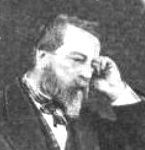 Open main menu
Open main menu
 Open main menu
Open main menu

T. Antisell
(1817 - 1893)
Home State: District Of Columbia
Education: Trinity College, Dublin (AB);
Trinity School of Medicine, Royal College of Surgeons (MD 1839);
Georgetown College (Ph.D 1881)
Command Billet: Medical Director
Branch of Service: Medical
Unit: Twelfth Army Corps
Before Antietam
After medical school he studied chemistry in Europe (1844) then practiced in Dublin (1845-48). A member of the Young Ireland Party, he was a founder and financial supporter of the revolutionary newspaper The Irish Tribune in June 1848 but it was shut down as seditious a month later. He sailed as ship's surgeon to New York in November 1848, possibly to avoid sedition charges. He practiced medicine in New York into 1854 then was a geologist on the Pacific Railroad Survey expedition. He was afterward Chemistry Examiner in the US Patent Office to 30 September 1861.
He was appointed Surgeon, US Volunteers on 2 October 1861. By August 1862 he was Medical Director of General Nathaniel Banks' Twelfth Army Corps.
On the Campaign
He was Medical Director of the Twelfth Army Corps on the Maryland Campaign of September 1862, and had the following summary of the new Corps commander's death at Antietam:
General Mansfield was wounded by a rifle bullet through the right breast, about 6 a. m. on the 17th, and died on the 18th at 8.15 a. m. Bullet entered between spine and scapula of right side and passed out two inches above and to outside of right nipple, between 3rd and 4th ribs.
The wound bled at first freely from posterior wound, and effusion into pleural sac augmented rapidly during the night of the 17th. He died of exhaustion.
The rest of the War
He was a surgeon at Harewood US Army General Hospital, Washington, DC by December 1862, and was Surgeon in Charge there by the end of the war. While posted there he was also a lecturer in medicine at Georgetown College. On 13 March 1865 he was honored by brevet to Lieutenant Colonel of Volunteers for his war service and he mustered out on 7 October 1865.
After the War
He was chief chemist at the US Department of Agriculture in Washington (1866-71), worked as a geologist and chemist in Japan to 1876, then returned to the Patent Office, where he was an Examiner to 1891, when he retired due to health.
References & notes
His service dates from Heitman.1 His role in Maryland and other details from Duncan.2 Personal details from family genealogists, the US Census of 1860, and his bio sketch in History of the Medical Society of the District of Columbia: 1817-1909 (1909). His gravesite is on Findagrave. His picture here from a photograph of unknown provenance hosted by Fenian Graves.
He married Eliza Anne Nowlan (1822-1852) in June 1840 in Dublin and they had 5 daughters. He married again, Marion Stuart Forsyth (1829-1882) in June 1854 in Detroit, MI, and they had as many as 5 more children.
Birth
01/16/1817; Dublin, IRELAND
Death
06/14/1893; Washington, DC; burial in Congressional Cemetery, Washington, DC
1 Heitman, Francis Bernard, Historical Register and Dictionary of the United States Army 1789-1903, 2 volumes, Washington DC: US Government Printing Office, 1903, Vol. 1, pg. 167 [AotW citation 28797]
2 Duncan, Louis C., and Captain, Medical Corps, US Army, The Medical Department of the United States Army in the Civil War: unpublished collection, c. 1916, pp. 22, 28, 45, 55 [AotW citation 28798]